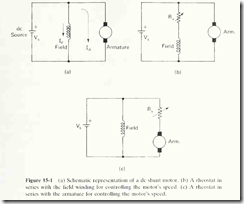Basically. th ere are two ways of varying the running speed of a de shunt motor:
1. Adjusting the voltage (and current) applied to the field winding. As the field voltage is increased, the motor slows down. This method is suggested by Fig. 15-1(b).
2.Adjusting the volta ge (and current) applied to the armature. As the armature voltage is increased. th e motor speeds up. This method is suggested by Fig. 15- l( c) .
Field control. H ere is how method 1, adjusting th e field voltage, works.
A s the field voltage is increased. by reducing R ,, in Fig. 15-1(b), for example , the
field current is increased. This results in a stron ger magnetic field, which induces a greater counter-EMF in the armature winding. The greater counter-EMF tends to oppose the applied de voltage and thus reduces the armature current, lA- There fore, an increased field curre nt causes the motor to slow down until the induced counter-EMF has r eturn ed to it s normal va l ue (approximately).
Going in th e other direction, if the field current is reduced, the magnetic fie ld get s wea ker. This ca u ses a reduction in counter-EMF created by the rotati n g ar mature winding. The armature current increases. forcing the motor to spin faster, until th e counter-EMF is once aga in approximately equal to what it was before. The reduction in magn etic field strength i s “compensated” for by an increase in armature speed .
This method of speed control ha s certain good features. It can he accomplished
by a smalL inexpen sive rh eostat , since th e current in the field winding is fairly low due to the large R f. Also, because of the low value of IF. the rheostat R ,. does not dissipate very much energy. Therefore, thi s method is energy-efficient.
Howev er. ther e i s one major drawback to speed con trol from th e field wind in g: To increase the speed, yo u must reduc e 11. and weaken the ma gn etic field, th ereby lesse nin g th e m otor ‘s torque-producing abilit y. The ability of a motor t o create torque depend s on two things: the current in th e armature conductors and th e strength of the magnetic field. As I F is reduced, the magnetic field is weakened, and the motor’s torque-producing ability declines. Unfortunately. it i s just now that the motor needs all th e torqu e-producing ability it can get, si nce it probably requires greater t orque to drive the load at a faster speed.
Thus. ther e i s a fundamental conflict involved with field control. To make the motor spin faster, which requir es it t o deliver more torque, you must do something which t e nds t o rob th e mot or of its ability to produce torque.
Armature control. From th e torque-producing point of view. method 2, armature controL is much better. As the armature voltage and current are increased [by r educi n g R ,. in Fig. 15-l(c)]. the motor starts running faster. which normally requires mor e t orq u e. The reason for the rise in speed is that the increased armature voltage demands an increased coun t er-EMF to limit the increase in armature cur rent t o a reasonable amount. The only way the counter-EMF can increase is for th e arma tur e winding to spin faster. since the magnetic field strength is fixed. In this instance, the ingredients are all present for increased torque production, since the magnetic field st ren gth is maint ained constant and lA is increased.
The problem with the armature control method of Fig. 15-1(c) is that R , . the
rheostat. must handle th e armature current. which is relatively large. Therefore the rheostat mu st be phyically large and expensive. and it will waste a considerable amount of energy.
Of the two methods illustrated in Fig. 15-l(b) and (c), the field control method is usua lly pr eferred
